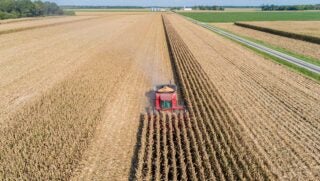“If you have more carbon entering your soil than leaving it, your kids will probably farm your land. If you have more carbon leaving your soil than entering it, they probably won’t.” — Jay Fuhrer, Soil Health Specialist, NRCS North Dakota
Agriculture has come to a fork in the road. The path each producer chooses to take could be the biggest decision she or he will make in their lifetime; or for the next generation that will farm their land. The question is, will you use current technology and data to restore your soil to its full potential, or use technology to only manage inputs while producing crops on increasingly dysfunctional soil? Treating the symptoms of unhealthy soil is expensive, never-ending, and bankrupting farmers and ranchers every year.
Today’s technology, unfortunately, allows us to manage impaired soil with precision. Continuing to prop up dysfunctional soil by more accurately meting out inputs is not the path to a prosperous future for anyone. We must solve the problem of degraded soil, not shore it up with inputs until the system collapses entirely.
Each of us has more than likely taken a turn solving a math problem at the blackboard (or dry-erase board as the case may be) in school. If you had a teacher like mine, you were not allowed to take your seat until you solved the problem. You were not allowed to simply erase the problem and walk away. When dealing with the soil, nature is the teacher, and it will not let you erase the problem and sit down — if you try to do so, it will just rewrite the problem again and again until you solve it. The tools of technology can be used to either help solve the problem we face with our soil or merely to erase it; only to revisit it again. It is all in how we choose to apply technology that will define our path.
Most of infrastructure of modern agriculture today is focused on mitigating the management of a dysfunctional resource (soil) with a variety of inputs. We spend a lot of time, money, and energy managing inputs that will mitigate our historic and present mistakes in soil management. Our incorrect understanding of how the soil functions has structured every part of how we now approach crop and livestock production. Most of the people employed in agriculture today have been trained and assigned to address the symptoms of faulty cropping or grazing systems applied to dysfunctional soil. But with an understanding of how the soil functions as a biological system, these same folks could take agriculture in a different direction toward sustainability of both farmers and the land they operate.
If you observe a piece of cropland that has been abandoned, you will see nature return it to the original vegetation while restoring the capacity of the soil to function again. This is the template for restoring soil. Less disturbance, more plant diversity, living roots as much of the time as possible, and keep the soil covered with plants and plant residues all of the time. Severe soil degradation has already occurred in some parts of the U.S. In 1914, almost 4 million acres of land were planted to cotton in Alabama; by 2015, only 1.5 million acres were growing any type of agricultural crop. Much of the 2.5 million acres that was used to grow crops back in 1914 is now back in forest; the native vegetation of the area. We now have both the technology and the understanding necessary to restore soil health while profitably producing agricultural crops. The choice is ours on how we wish to proceed with crop production; on a path that restores the soil, or one that continues to degrade it.
I am hopeful as I observe an ever increasing number of producers grasp the concepts of restoring soil health on their land. At the same time, I am concerned for the producers who are still on the path of input-agriculture and are not aware that their soil most likely continues to decline in its capacity to function. For perhaps the first time in the approximately 7,000-year history of human agriculture, we have a generation of farmers who are restoring, rather than degrading the soil. The Green Revolution of the mid-20th century did wonders to feed the humans on this planet, but exacted a terrible toll on our agricultural soils.
Clearly, using the latest technology to simply apply inputs with greater efficiency into soils managed in a downward spiral is not the answer. The path of restoring the capacity of the soil to function again is the only path in agriculture with a future.
Jon Stika is a soil scientist who has worked with the North Dakota Soil Conservation Committee and NDSU’s Dickinson Research and Extension Center. He is also the author of “A Soil Owner’s Manual: How to Restore and Maintain Soil Health.”



